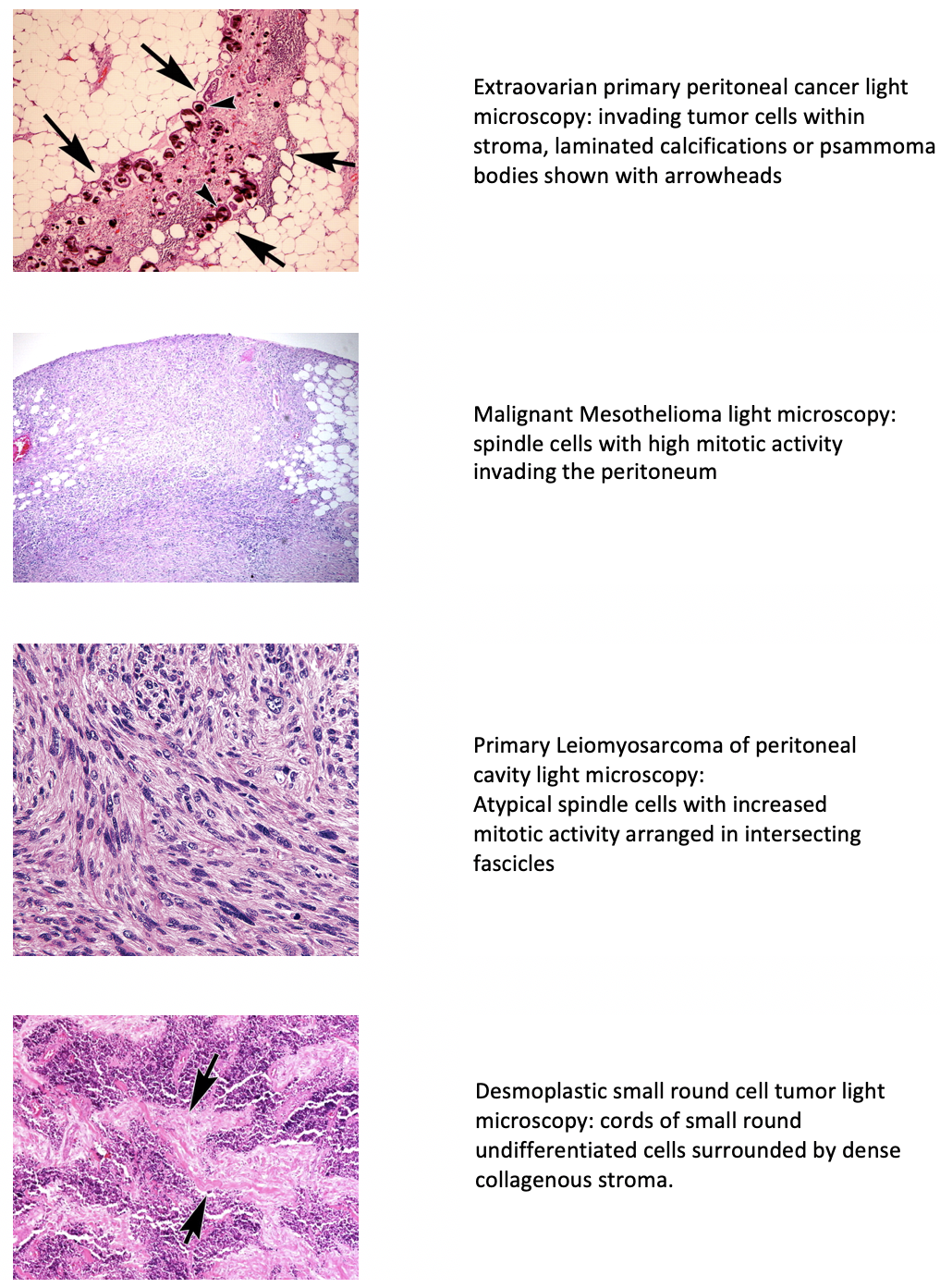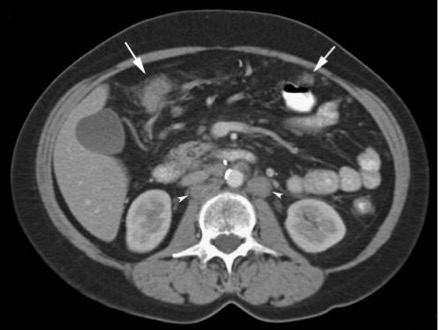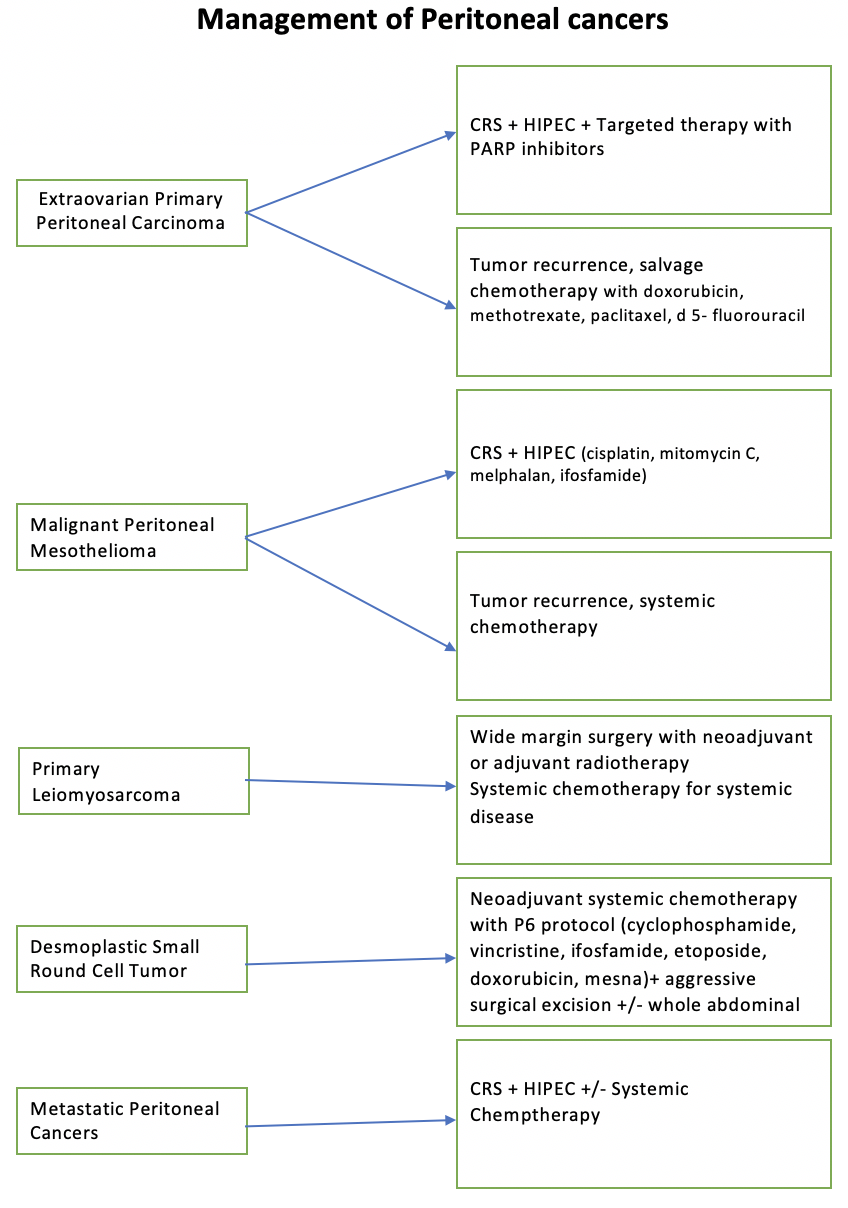[1]
Eltabbakh GH, Piver MS. Extraovarian primary peritoneal carcinoma. Oncology (Williston Park, N.Y.). 1998 Jun:12(6):813-9; discussion 820, 825-6
[PubMed PMID: 9644683]
[2]
Levy AD, Arnáiz J, Shaw JC, Sobin LH. From the archives of the AFIP: primary peritoneal tumors: imaging features with pathologic correlation. Radiographics : a review publication of the Radiological Society of North America, Inc. 2008 Mar-Apr:28(2):583-607; quiz 621-2. doi: 10.1148/rg.282075175. Epub
[PubMed PMID: 18349460]
[3]
SWERDLOW M. Mesothelioma of the pelvic peritoneum resembling papillary cystadenocarcinoma of the ovary; case report. American journal of obstetrics and gynecology. 1959 Jan:77(1):197-200
[PubMed PMID: 13606191]
Level 3 (low-level) evidence
[4]
Sampson JA. Implantation Peritoneal Carcinomatosis of Ovarian Origin. The American journal of pathology. 1931 Sep:7(5):423-444.39
[PubMed PMID: 19969977]
[5]
Boussios S, Moschetta M, Karathanasi A, Tsiouris AK, Kanellos FS, Tatsi K, Katsanos KH, Christodoulou DK. Malignant peritoneal mesothelioma: clinical aspects, and therapeutic perspectives. Annals of gastroenterology. 2018 Nov-Dec:31(6):659-669. doi: 10.20524/aog.2018.0305. Epub 2018 Sep 14
[PubMed PMID: 30386115]
Level 3 (low-level) evidence
[6]
Sawyer JR, Tryka AF, Lewis JM. A novel reciprocal chromosome translocation t(11;22)(p13;q12) in an intraabdominal desmoplastic small round-cell tumor. The American journal of surgical pathology. 1992 Apr:16(4):411-6
[PubMed PMID: 1314522]
[7]
Goodman MT, Shvetsov YB. Incidence of ovarian, peritoneal, and fallopian tube carcinomas in the United States, 1995-2004. Cancer epidemiology, biomarkers & prevention : a publication of the American Association for Cancer Research, cosponsored by the American Society of Preventive Oncology. 2009 Jan:18(1):132-9. doi: 10.1158/1055-9965.EPI-08-0771. Epub
[PubMed PMID: 19124490]
[8]
Coccolini F, Gheza F, Lotti M, Virzì S, Iusco D, Ghermandi C, Melotti R, Baiocchi G, Giulini SM, Ansaloni L, Catena F. Peritoneal carcinomatosis. World journal of gastroenterology. 2013 Nov 7:19(41):6979-94. doi: 10.3748/wjg.v19.i41.6979. Epub
[PubMed PMID: 24222942]
[9]
Rodríguez D, Cheung MC, Housri N, Koniaris LG. Malignant abdominal mesothelioma: defining the role of surgery. Journal of surgical oncology. 2009 Jan 1:99(1):51-7. doi: 10.1002/jso.21167. Epub
[PubMed PMID: 18942074]
[10]
Bharti JN, Dey B, Desai P, Gupta R, Khurana N, Gandhi G. Primary leiomyosarcoma of peritoneal cavity. Rare tumors. 2014 Jan 23:6(1):5165. doi: 10.4081/rt.2014.5165. Epub 2014 Mar 26
[PubMed PMID: 24711906]
[11]
Lengyel E. Ovarian cancer development and metastasis. The American journal of pathology. 2010 Sep:177(3):1053-64. doi: 10.2353/ajpath.2010.100105. Epub 2010 Jul 22
[PubMed PMID: 20651229]
[12]
Levy AD, Shaw JC, Sobin LH. Secondary tumors and tumorlike lesions of the peritoneal cavity: imaging features with pathologic correlation. Radiographics : a review publication of the Radiological Society of North America, Inc. 2009 Mar-Apr:29(2):347-73. doi: 10.1148/rg.292085189. Epub
[PubMed PMID: 19325052]
[13]
Nadler A, McCart JA, Govindarajan A. Peritoneal Carcinomatosis from Colon Cancer: A Systematic Review of the Data for Cytoreduction and Intraperitoneal Chemotherapy. Clinics in colon and rectal surgery. 2015 Dec:28(4):234-46. doi: 10.1055/s-0035-1564431. Epub
[PubMed PMID: 26648794]
Level 1 (high-level) evidence
[14]
Thomassen I, van Gestel YR, van Ramshorst B, Luyer MD, Bosscha K, Nienhuijs SW, Lemmens VE, de Hingh IH. Peritoneal carcinomatosis of gastric origin: a population-based study on incidence, survival and risk factors. International journal of cancer. 2014 Feb 1:134(3):622-8. doi: 10.1002/ijc.28373. Epub 2013 Aug 5
[PubMed PMID: 23832847]
[15]
Flanagan M, Solon J, Chang KH, Deady S, Moran B, Cahill R, Shields C, Mulsow J. Peritoneal metastases from extra-abdominal cancer - A population-based study. European journal of surgical oncology : the journal of the European Society of Surgical Oncology and the British Association of Surgical Oncology. 2018 Nov:44(11):1811-1817. doi: 10.1016/j.ejso.2018.07.049. Epub 2018 Jul 26
[PubMed PMID: 30139510]
[16]
Pannu HK, Oliphant M. The subperitoneal space and peritoneal cavity: basic concepts. Abdominal imaging. 2015 Oct:40(7):2710-22. doi: 10.1007/s00261-015-0429-5. Epub
[PubMed PMID: 26006061]
[17]
Liu J, Geng X, Li Y. Milky spots: omental functional units and hotbeds for peritoneal cancer metastasis. Tumour biology : the journal of the International Society for Oncodevelopmental Biology and Medicine. 2016 May:37(5):5715-26. doi: 10.1007/s13277-016-4887-3. Epub 2016 Jan 29
[PubMed PMID: 26831659]
[18]
Langley RR, Fidler IJ. The seed and soil hypothesis revisited--the role of tumor-stroma interactions in metastasis to different organs. International journal of cancer. 2011 Jun 1:128(11):2527-35. doi: 10.1002/ijc.26031. Epub 2011 Mar 25
[PubMed PMID: 21365651]
[19]
Mikuła-Pietrasik J, Uruski P, Tykarski A, Książek K. The peritoneal "soil" for a cancerous "seed": a comprehensive review of the pathogenesis of intraperitoneal cancer metastases. Cellular and molecular life sciences : CMLS. 2018 Feb:75(3):509-525. doi: 10.1007/s00018-017-2663-1. Epub 2017 Sep 27
[PubMed PMID: 28956065]
[20]
Sugarbaker EV. Cancer metastasis: a product of tumor-host interactions. Current problems in cancer. 1979 Jan:3(7):1-59
[PubMed PMID: 371913]
[21]
Kusamura S, Baratti D, Zaffaroni N, Villa R, Laterza B, Balestra MR, Deraco M. Pathophysiology and biology of peritoneal carcinomatosis. World journal of gastrointestinal oncology. 2010 Jan 15:2(1):12-8. doi: 10.4251/wjgo.v2.i1.12. Epub
[PubMed PMID: 21160812]
[22]
Lemoine L, Sugarbaker P, Van der Speeten K. Pathophysiology of colorectal peritoneal carcinomatosis: Role of the peritoneum. World journal of gastroenterology. 2016 Sep 14:22(34):7692-707. doi: 10.3748/wjg.v22.i34.7692. Epub
[PubMed PMID: 27678351]
[23]
Kannerstein M, Churg J, McCaughey WT, Hill DP. Papillary tumors of the peritoneum in women: mesothelioma or papillary carcinoma. American journal of obstetrics and gynecology. 1977 Feb 1:127(3):306-14
[PubMed PMID: 835626]
[24]
Schorge JO, Muto MG, Lee SJ, Huang LW, Welch WR, Bell DA, Keung EZ, Berkowitz RS, Mok SC. BRCA1-related papillary serous carcinoma of the peritoneum has a unique molecular pathogenesis. Cancer research. 2000 Mar 1:60(5):1361-4
[PubMed PMID: 10728699]
[25]
Gu J, Roth LM, Younger C, Michael H, Abdul-Karim FW, Zhang S, Ulbright TM, Eble JN, Cheng L. Molecular evidence for the independent origin of extra-ovarian papillary serous tumors of low malignant potential. Journal of the National Cancer Institute. 2001 Aug 1:93(15):1147-52
[PubMed PMID: 11481386]
[26]
Sekido Y. Molecular pathogenesis of malignant mesothelioma. Carcinogenesis. 2013 Jul:34(7):1413-9. doi: 10.1093/carcin/bgt166. Epub 2013 May 14
[PubMed PMID: 23677068]
[27]
George S, Serrano C, Hensley ML, Ray-Coquard I. Soft Tissue and Uterine Leiomyosarcoma. Journal of clinical oncology : official journal of the American Society of Clinical Oncology. 2018 Jan 10:36(2):144-150. doi: 10.1200/JCO.2017.75.9845. Epub 2017 Dec 8
[PubMed PMID: 29220301]
[28]
Thway K, Noujaim J, Zaidi S, Miah AB, Benson C, Messiou C, Jones RL, Fisher C. Desmoplastic Small Round Cell Tumor: Pathology, Genetics, and Potential Therapeutic Strategies. International journal of surgical pathology. 2016 Dec:24(8):672-684
[PubMed PMID: 27621277]
[29]
Bhuyan P, Mahapatra S, Mahapatra S, Sethy S, Parida P, Satpathy S. Extraovarian primary peritoneal papillary serous carcinoma. Archives of gynecology and obstetrics. 2010 Mar:281(3):561-4. doi: 10.1007/s00404-009-1201-2. Epub 2009 Aug 20
[PubMed PMID: 19693524]
[30]
Watanabe T, Miyamoto S, Kitagori K, Horimatsu T, Morita S, Mashimo Y, Ezoe Y, Muto M, Chiba T. A case of long-term survival of metastatic desmoplastic small round cell tumor treated with multimodal therapy. Oncology letters. 2012 Jan:3(1):30-34
[PubMed PMID: 22740851]
Level 3 (low-level) evidence
[31]
Sadeghi B, Arvieux C, Glehen O, Beaujard AC, Rivoire M, Baulieux J, Fontaumard E, Brachet A, Caillot JL, Faure JL, Porcheron J, Peix JL, François Y, Vignal J, Gilly FN. Peritoneal carcinomatosis from non-gynecologic malignancies: results of the EVOCAPE 1 multicentric prospective study. Cancer. 2000 Jan 15:88(2):358-63
[PubMed PMID: 10640968]
[32]
Goerg C, Schwerk WB. Malignant ascites: sonographic signs of peritoneal carcinomatosis. European journal of cancer (Oxford, England : 1990). 1991:27(6):720-3
[PubMed PMID: 1829911]
[33]
Weill FS, Costaz R, Guetarni S, Maltoni I, Rohmer P. [Echographic diagnosis of peritoneal metastases in patients with ascites]. Journal de radiologie. 1990 May:71(5):365-8
[PubMed PMID: 2213700]
[34]
Patel CM, Sahdev A, Reznek RH. CT, MRI and PET imaging in peritoneal malignancy. Cancer imaging : the official publication of the International Cancer Imaging Society. 2011 Aug 24:11(1):123-39. doi: 10.1102/1470-7330.2011.0016. Epub 2011 Aug 24
[PubMed PMID: 21865109]
[35]
Chiou SY, Sheu MH, Wang JH, Chang CY. Peritoneal serous papillary carcinoma: a reappraisal of CT imaging features and literature review. Abdominal imaging. 2003 Nov-Dec:28(6):815-9
[PubMed PMID: 14753596]
[36]
Kim J, Bhagwandin S, Labow DM. Malignant peritoneal mesothelioma: a review. Annals of translational medicine. 2017 Jun:5(11):236. doi: 10.21037/atm.2017.03.96. Epub
[PubMed PMID: 28706904]
[38]
De Gaetano AM, Calcagni ML, Rufini V, Valenza V, Giordano A, Bonomo L. Imaging of peritoneal carcinomatosis with FDG PET-CT: diagnostic patterns, case examples and pitfalls. Abdominal imaging. 2009 May-Jun:34(3):391-402. doi: 10.1007/s00261-008-9405-7. Epub
[PubMed PMID: 18446399]
Level 3 (low-level) evidence
[39]
Runyon BA, Hoefs JC, Morgan TR. Ascitic fluid analysis in malignancy-related ascites. Hepatology (Baltimore, Md.). 1988 Sep-Oct:8(5):1104-9
[PubMed PMID: 3417231]
[40]
Huang LL, Xia HH, Zhu SL. Ascitic Fluid Analysis in the Differential Diagnosis of Ascites: Focus on Cirrhotic Ascites. Journal of clinical and translational hepatology. 2014 Mar:2(1):58-64. doi: 10.14218/JCTH.2013.00010. Epub 2014 Mar 15
[PubMed PMID: 26357618]
[41]
Tuzun Y, Celik Y, Bayan K, Yilmaz S, Dursun M, Canoruc F. Correlation of tumour markers in ascitic fluid and serum: are measurements of ascitic tumour markers a futile attempt? The Journal of international medical research. 2009 Jan-Feb:37(1):79-86
[PubMed PMID: 19215676]
[42]
Liu F, Kong X, Dou Q, Ye J, Xu D, Shang H, Xu K, Song Y. Evaluation of tumor markers for the differential diagnosis of benign and malignant ascites. Annals of hepatology. 2014 May-Jun:13(3):357-63
[PubMed PMID: 24756011]
[43]
Rodriguez EF, Monaco SE, Khalbuss W, Austin RM, Pantanowitz L. Abdominopelvic washings: A comprehensive review. CytoJournal. 2013:10():7. doi: 10.4103/1742-6413.111080. Epub 2013 Apr 24
[PubMed PMID: 23858317]
[44]
Maseki Z, Kajiyama H, Nishikawa E, Satake T, Misawa T, Kikkawa F. Is cell block technique useful to predict histological type in patients with ovarian mass and/or body cavity fluids? Nagoya journal of medical science. 2020 May:82(2):225-235. doi: 10.18999/nagjms.82.2.225. Epub
[PubMed PMID: 32581403]
[45]
Elzarkaa AA, Shaalan W, Elemam D, Mansour H, Melis M, Malik E, Soliman AA. Peritoneal cancer index as a predictor of survival in advanced stage serous epithelial ovarian cancer: a prospective study. Journal of gynecologic oncology. 2018 Jul:29(4):e47. doi: 10.3802/jgo.2018.29.e47. Epub 2018 Mar 8
[PubMed PMID: 29770618]
[46]
Burnett A, Lecompte MA, Trabulsi N, Dubé P, Gervais MK, Trilling B, Cloutier AS, Sideris L. Peritoneal carcinomatosis index predicts survival in colorectal patients undergoing HIPEC using oxaliplatin: a retrospective single-arm cohort study. World journal of surgical oncology. 2019 May 15:17(1):83. doi: 10.1186/s12957-019-1618-4. Epub 2019 May 15
[PubMed PMID: 31092250]
Level 2 (mid-level) evidence
[47]
Lungoci C, Mironiuc AI, Muntean V, Oniu T, Leebmann H, Mayr M, Piso P. Multimodality treatment strategies have changed prognosis of peritoneal metastases. World journal of gastrointestinal oncology. 2016 Jan 15:8(1):67-82. doi: 10.4251/wjgo.v8.i1.67. Epub
[PubMed PMID: 26798438]
[48]
Armstrong DK, Bundy B, Wenzel L, Huang HQ, Baergen R, Lele S, Copeland LJ, Walker JL, Burger RA, Gynecologic Oncology Group. Intraperitoneal cisplatin and paclitaxel in ovarian cancer. The New England journal of medicine. 2006 Jan 5:354(1):34-43
[PubMed PMID: 16394300]
[49]
Hayes-Jordan A, LaQuaglia MP, Modak S. Management of desmoplastic small round cell tumor. Seminars in pediatric surgery. 2016 Oct:25(5):299-304. doi: 10.1053/j.sempedsurg.2016.09.005. Epub 2016 Sep 14
[PubMed PMID: 27955733]
[50]
Mehta SS, Bhatt A, Glehen O. Cytoreductive Surgery and Peritonectomy Procedures. Indian journal of surgical oncology. 2016 Jun:7(2):139-51. doi: 10.1007/s13193-016-0505-5. Epub 2016 Feb 3
[PubMed PMID: 27065704]
[51]
Shaligram A. Management of peritoneal surface malignancies in laparoscopic era: a concise review. International journal of surgery. Oncology. 2016 Dec:1(2):e05. doi: 10.1097/IJ9.0000000000000005. Epub 2016 Nov 11
[PubMed PMID: 29177208]
[52]
Facchiano E, Risio D, Kianmanesh R, Msika S. Laparoscopic hyperthermic intraperitoneal chemotherapy: indications, aims, and results: a systematic review of the literature. Annals of surgical oncology. 2012 Sep:19(9):2946-50. doi: 10.1245/s10434-012-2360-0. Epub 2012 Apr 24
[PubMed PMID: 22526907]
Level 1 (high-level) evidence
[53]
Jayakrishnan TT, Zacharias AJ, Sharma A, Pappas SG, Gamblin TC, Turaga KK. Role of laparoscopy in patients with peritoneal metastases considered for cytoreductive surgery and hyperthermic intraperitoneal chemotherapy (HIPEC). World journal of surgical oncology. 2014 Aug 21:12():270. doi: 10.1186/1477-7819-12-270. Epub 2014 Aug 21
[PubMed PMID: 25145962]
[54]
Yurttas C, Hoffmann G, Tolios A, Haen SP, Schwab M, Königsrainer I, Königsrainer A, Beckert S, Löffler MW. Systematic Review of Variations in Hyperthermic Intraperitoneal Chemotherapy (HIPEC) for Peritoneal Metastasis from Colorectal Cancer. Journal of clinical medicine. 2018 Dec 19:7(12):. doi: 10.3390/jcm7120567. Epub 2018 Dec 19
[PubMed PMID: 30572653]
Level 1 (high-level) evidence
[55]
Sugarbaker PH, Graves T, DeBruijn EA, Cunliffe WJ, Mullins RE, Hull WE, Oliff L, Schlag P. Early postoperative intraperitoneal chemotherapy as an adjuvant therapy to surgery for peritoneal carcinomatosis from gastrointestinal cancer: pharmacological studies. Cancer research. 1990 Sep 15:50(18):5790-4
[PubMed PMID: 2118420]
[56]
Goodman MD, McPartland S, Detelich D, Saif MW. Chemotherapy for intraperitoneal use: a review of hyperthermic intraperitoneal chemotherapy and early post-operative intraperitoneal chemotherapy. Journal of gastrointestinal oncology. 2016 Feb:7(1):45-57. doi: 10.3978/j.issn.2078-6891.2015.111. Epub
[PubMed PMID: 26941983]
[57]
Klaver YL, Hendriks T, Lomme RM, Rutten HJ, Bleichrodt RP, de Hingh IH. Intraoperative versus early postoperative intraperitoneal chemotherapy after cytoreduction for colorectal peritoneal carcinomatosis: an experimental study. Annals of surgical oncology. 2012 Jul:19 Suppl 3():S475-82. doi: 10.1245/s10434-011-1984-9. Epub 2011 Aug 12
[PubMed PMID: 21837528]
[58]
Elias D, Benizri E, Di Pietrantonio D, Menegon P, Malka D, Raynard B. Comparison of two kinds of intraperitoneal chemotherapy following complete cytoreductive surgery of colorectal peritoneal carcinomatosis. Annals of surgical oncology. 2007 Feb:14(2):509-14
[PubMed PMID: 17096054]
[59]
Tan GH, Ong WS, Chia CS, Tham CK, Soo KC, Teo MC. Does early post-operative intraperitoneal chemotherapy (EPIC) for patients treated with cytoreductive surgery and hyperthermic intraperitoneal chemotherapy (HIPEC) make a difference? International journal of hyperthermia : the official journal of European Society for Hyperthermic Oncology, North American Hyperthermia Group. 2016 May:32(3):281-8. doi: 10.3109/02656736.2015.1135485. Epub 2016 Feb 10
[PubMed PMID: 26862667]
[60]
Kurtz F, Struller F, Horvath P, Solass W, Bösmüller H, Königsrainer A, Reymond MA. Feasibility, Safety, and Efficacy of Pressurized Intraperitoneal Aerosol Chemotherapy (PIPAC) for Peritoneal Metastasis: A Registry Study. Gastroenterology research and practice. 2018:2018():2743985. doi: 10.1155/2018/2743985. Epub 2018 Oct 24
[PubMed PMID: 30473706]
Level 2 (mid-level) evidence
[61]
Robella M, Vaira M, De Simone M. Safety and feasibility of pressurized intraperitoneal aerosol chemotherapy (PIPAC) associated with systemic chemotherapy: an innovative approach to treat peritoneal carcinomatosis. World journal of surgical oncology. 2016 Apr 29:14():128. doi: 10.1186/s12957-016-0892-7. Epub 2016 Apr 29
[PubMed PMID: 27125996]
Level 2 (mid-level) evidence
[62]
Gockel I, Jansen-Winkeln B, Haase L, Niebisch S, Moulla Y, Lyros O, Lordick F, Schierle K, Wittekind C, Thieme R. Pressurized IntraPeritoneal Aerosol Chemotherapy (PIPAC) in patients with peritoneal metastasized colorectal, appendiceal and small bowel cancer. Tumori. 2020 Feb:106(1):70-78. doi: 10.1177/0300891619868013. Epub 2019 Aug 30
[PubMed PMID: 31469058]
[63]
Gockel I, Jansen-Winkeln B, Haase L, Rhode P, Mehdorn M, Niebisch S, Moulla Y, Lyros O, Lordick F, Schierle K, Wittekind C, Thieme R. Pressurized Intraperitoneal Aerosol Chemotherapy (PIPAC) in Gastric Cancer Patients with Peritoneal Metastasis (PM): Results of a Single-Center Experience and Register Study. Journal of gastric cancer. 2018 Dec:18(4):379-391. doi: 10.5230/jgc.2018.18.e37. Epub 2018 Dec 14
[PubMed PMID: 30607301]
[64]
Tempfer C, Giger-Pabst U, Hilal Z, Dogan A, Rezniczek GA. Pressurized intraperitoneal aerosol chemotherapy (PIPAC) for peritoneal carcinomatosis: systematic review of clinical and experimental evidence with special emphasis on ovarian cancer. Archives of gynecology and obstetrics. 2018 Aug:298(2):243-257. doi: 10.1007/s00404-018-4784-7. Epub 2018 Jun 4
[PubMed PMID: 29869089]
Level 1 (high-level) evidence
[65]
Koumpa FS, Xylas D, Konopka M, Galea D, Veselkov K, Antoniou A, Mehta A, Mirnezami R. Colorectal Peritoneal Metastases: A Systematic Review of Current and Emerging Trends in Clinical and Translational Research. Gastroenterology research and practice. 2019:2019():5180895. doi: 10.1155/2019/5180895. Epub 2019 Apr 1
[PubMed PMID: 31065262]
Level 1 (high-level) evidence
[66]
Nadiradze G, Horvath P, Sautkin Y, Archid R, Weinreich FJ, Königsrainer A, Reymond MA. Overcoming Drug Resistance by Taking Advantage of Physical Principles: Pressurized Intraperitoneal Aerosol Chemotherapy (PIPAC). Cancers. 2019 Dec 20:12(1):. doi: 10.3390/cancers12010034. Epub 2019 Dec 20
[PubMed PMID: 31877647]
[67]
Ploug M, Graversen M, Pfeiffer P, Mortensen MB. Bidirectional treatment of peritoneal metastasis with Pressurized IntraPeritoneal Aerosol Chemotherapy (PIPAC) and systemic chemotherapy: a systematic review. BMC cancer. 2020 Feb 10:20(1):105. doi: 10.1186/s12885-020-6572-6. Epub 2020 Feb 10
[PubMed PMID: 32041558]
Level 1 (high-level) evidence
[68]
Piura B, Meirovitz M, Bartfeld M, Yanai-Inbar I, Cohen Y. Peritoneal papillary serous carcinoma: study of 15 cases and comparison with stage III-IV ovarian papillary serous carcinoma. Journal of surgical oncology. 1998 Jul:68(3):173-8
[PubMed PMID: 9701210]
Level 3 (low-level) evidence
[69]
Gilly FN, Carry PY, Sayag AC, Brachet A, Panteix G, Salle B, Bienvenu J, Burgard G, Guibert B, Banssillon V. Regional chemotherapy (with mitomycin C) and intra-operative hyperthermia for digestive cancers with peritoneal carcinomatosis. Hepato-gastroenterology. 1994 Apr:41(2):124-9
[PubMed PMID: 8056398]
[70]
Yun WS, Bae JM. Primary peritoneal serous carcinoma, an extremely rare malignancy: A case report and review of the literature. Oncology letters. 2016 Jun:11(6):4063-4065
[PubMed PMID: 27313741]
Level 3 (low-level) evidence
[71]
Eltabbakh GH, Werness BA, Piver S, Blumenson LE. Prognostic factors in extraovarian primary peritoneal carcinoma. Gynecologic oncology. 1998 Nov:71(2):230-9
[PubMed PMID: 9826465]
[72]
Liu S, Staats P, Lee M, Alexander HR, Burke AP. Diffuse mesothelioma of the peritoneum: correlation between histological and clinical parameters and survival in 73 patients. Pathology. 2014 Dec:46(7):604-9. doi: 10.1097/PAT.0000000000000181. Epub
[PubMed PMID: 25393250]
[73]
Wong HH, Hatcher HM, Benson C, Al-Muderis O, Horan G, Fisher C, Earl HM, Judson I. Desmoplastic small round cell tumour: characteristics and prognostic factors of 41 patients and review of the literature. Clinical sarcoma research. 2013 Nov 26:3(1):14. doi: 10.1186/2045-3329-3-14. Epub 2013 Nov 26
[PubMed PMID: 24280007]
[74]
Harmon RL, Sugarbaker PH. Prognostic indicators in peritoneal carcinomatosis from gastrointestinal cancer. International seminars in surgical oncology : ISSO. 2005 Feb 8:2(1):3
[PubMed PMID: 15701175]
[75]
Vaira M, Cioppa T, D'Amico S, de Marco G, D'Alessandro M, Fiorentini G, De Simone M. Treatment of peritoneal carcinomatosis from colonic cancer by cytoreduction, peritonectomy and hyperthermic intraperitoneal chemotherapy (HIPEC). Experience of ten years. In vivo (Athens, Greece). 2010 Jan-Feb:24(1):79-84
[PubMed PMID: 20133981]
[76]
Tentes AA, Tripsiannis G, Markakidis SK, Karanikiotis CN, Tzegas G, Georgiadis G, Avgidou K. Peritoneal cancer index: a prognostic indicator of survival in advanced ovarian cancer. European journal of surgical oncology : the journal of the European Society of Surgical Oncology and the British Association of Surgical Oncology. 2003 Feb:29(1):69-73
[PubMed PMID: 12559080]
[77]
McMullen JRW, Selleck M, Wall NR, Senthil M. Peritoneal carcinomatosis: limits of diagnosis and the case for liquid biopsy. Oncotarget. 2017 Jun 27:8(26):43481-43490. doi: 10.18632/oncotarget.16480. Epub
[PubMed PMID: 28415645]
Level 3 (low-level) evidence



